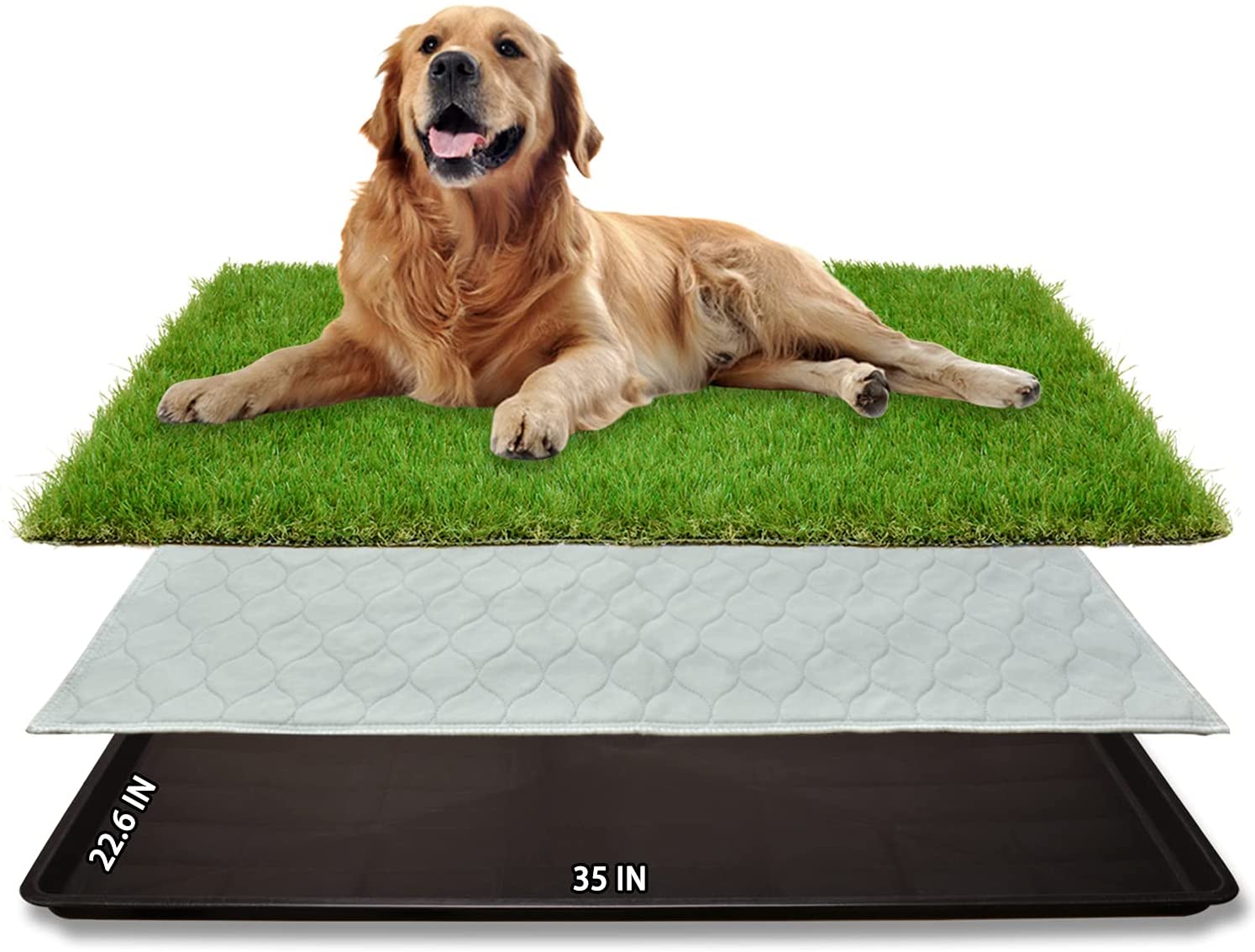What to put under artificial grass for dogs today!
Installing artificial grass on the lawn or in the backyard is now becoming the norm. Why?
Because artificial grass is so much better than natural grass. Natural grass makes the surface muddy, pesticides, and many small animals live, or insects build their nest there. In other words, keeping natural green grass clean and just the way, you want requires a lot of effort, which is not needed for artificial grass.
But you can’t just buy it and put it there, especially if you have dogs. They will do their number one and two and leave it dirty, smelly, and unhygienic for you and your loved ones. Work must be done beforehand. So, what to put under artificial grass for dogs? Read on to find out.
What to put under artificial grass for dogs?
Artificial grass usually lasts 10-15 years once you complete the minimum effort to protect it. We take for granted that you have dogs and will consider the worst possible scenario. Now we show you how to prepare the area for artificial grass before installation.
Preparing the Area
It takes time before you start your artificial grass installment, and frankly, it also takes effort. Follow these steps to prepare the area for installing artificial grass, according to ASPCA.org
Kill the Weeds
You cannot have existing vegetation in the area of artificial grass. If the weed survives after installment, it will expand and invite pests and insects.
So weeds must be gone- No compromise. Different sprays are available for killing weeds on the ground. Use them according to the instructions. Start this step at least 2 weeks before installments.
Remove the Top Layer
The upper surface of the ground must be removed so that the artificial grass can be installed there. Use a small rototiller to remove up to 3 or 4 inches of the turf. Existing grass or other plants must also be removed, and the surface will not be even.
To prevent slumping, the soil must be left to dry for a few days. The surface should be smooth, but a little inclination is also good.
Define a Border
Once you are done making the surface, now you make the border. Define an area for the artificial grass and surround the area with a waterproof border. This can be done by pouring a concrete curb around the area instead. Make sure the border won’t protrude above the grass height.
Add a Geotextile Barrier
Even if the area is properly prepared, weeds can still reach the artificial grass and live through it. To prevent this, a geotextile barrier can be added at the bottom of the excavated area. This can also be installed over the base material as well.
Here’s a list what you need to check out.
| Material | Description | Pros | Cons |
| Crushed Stone | Gravel or crushed rock | Allows for good drainage | Can be uncomfortable for dogs to walk on |
| Sand | Granular material | Provides good drainage and stability | Can be easily displaced by active dogs |
| Drainage Mat | Synthetic or rubber mat | Provides drainage and stability | Can be expensive |
| Shock Pad | Foam padding | Provides cushioning for dogs | Can be expensive |
| Concrete | Hard, durable surface | Easy to clean | Can be uncomfortable for dogs to walk on, can be slippery when wet |
| Wood Decking | Elevated platform made of wood | Provides a natural look | Requires maintenance and can be slippery when wet |
| Geo-textile Fabric | Permeable, non-woven fabric | Helps prevent weeds from growing | Does not provide drainage or cushioning. |
Things to Put Under Artificial Grass for Dogs
Here are some things you can put consider putting under your turf for dogs:
- Gravel: Gravel is a popular option for a base layer because it promotes drainage and prevents water from pooling on the surface. It’s important to choose a size and type of gravel that won’t shift or move over time. A layer of geotextile fabric can be placed over the gravel to prevent weeds from growing through and to keep the gravel in place. It’s important to note that a layer of gravel alone may not provide enough cushioning for your dog and may not be suitable for heavy use areas.
- Sand: Sand is another option for a base layer for artificial grass. It can help to improve drainage and provide a cushioned surface for your dog to walk and play on. Like gravel, it’s important to choose a type of sand that won’t shift or move over time. A layer of geotextile fabric can be placed over the sand to prevent weeds from growing through and to keep the sand in place. It’s important to note that a layer of sand alone may not provide enough cushioning for your dog and may not be suitable for heavy use areas.
- Crushed stone: Crushed stone can be used as a base layer for artificial grass to promote drainage and prevent odors. It’s important to choose a size and type of stone that won’t shift or move over time. A layer of geotextile fabric can be placed over the crushed stone to prevent weeds from growing through and to keep the stone in place. Crushed stone can provide a good balance of drainage and cushioning, making it a suitable option for heavy use areas.
- Shock pad: A shock pad is a cushioned layer that can be placed beneath the artificial grass to provide a comfortable and safe surface for your dog. It can help to absorb impact and reduce the risk of injuries. Shock pads are made from materials such as rubber, foam, or a combination of both. They come in different thicknesses and densities, so it’s important to choose one that is appropriate for the level of use the area will receive. Shock pads are more expensive than other options but can provide the most cushioning and safety.
- Foam underlay: Foam underlay is another option for providing a cushioned surface for your dog to play on. It can help to improve drainage and prevent odors, and it’s easy to install. Foam underlay is typically made from closed-cell foam and comes in different thicknesses. It’s important to choose one that is appropriate for the level of use the area will receive. Foam underlay can provide a good balance of cushioning and drainage and is suitable for moderate use areas.
Bottom Line
In your ever-growing busy life, it’s hard to find time to look after a lawn regularly. So, an artificial lawn could be right for you. It requires low maintenance and is dog friendly. Moreover, its flexible design option gives you a green and vibrant space to enjoy all year.
Here, you have learned about what to put under artificial grass for dogs. If you are thinking about installing artificial grass on your lawn, Good Choice! But remember what needs to be done.
With outstanding experience as a content strategist, Nesar leads the team with exceptional strategies and techniques. He has a solid understanding of the company's marketing strategy and how it will be implemented on all platforms and has the capability to communicate that information effectively with other departments within the organization.
Further, with his deep understanding of marketing and relative fields he plans to the business goals will be achieved. For over a year, Nesar’s contribution to The Greenoma is unparalleled and his sheer skill and firm determination has made us who we are today.

